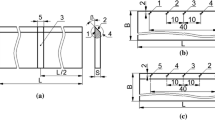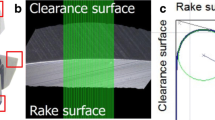Abstract
This paper presents the comparative analysis of M-35 high-speed steel tool with the cryogenic and conventional heat treatment process. Phase transformation is an effective way to improve the tool material properties. The investigation observes the influence of the cryogenic process on roughness and tool wear of M35 single point cutting tool. It observed that for a cryogenic tool due to an increase in the hardness, the resistance of the work piece become low. Moreover, scanning and microscopy performed using a scanning electron microscope to analyses the variation in microstructure characteristics. The analysis of variance (ANOVA) technique has employed to investigate the highest contributing factor process parameters with experimental validation. The tool steel electrodes are carried out with heat treatment that gives the desired results. The treatment at a very low temperature at cryogenic state is carried out.








Similar content being viewed by others
References
SreeramaReddy TV, Sornakumar T, VenkataramaReddy M, Venkatram R (2009) Machinability of C45 steel with deepcryogenic treated tungsten carbide cutting tool inserts. Int J Refract Metal Hard Mater 27:181–185
Khan AA, Ahmed MI (2008) Improving tool life using cryogenic cooling. J Mater Process Technol 196:149–154
Gill SS, Rupinder Singh R, Singh H, Singh J (2009) Wear behaviour of cryogenically treated tungsten carbide inserts under dry and wet turning conditions. Int J Mach Tools Manuf 49:256–260
Silva FJ, Franco SD, Machado AR, Ezugwu EO, Souza AMJ (2006) Performance of cryogenically treated HSS tools. Wear 261:674–685
Preciado M, Bravo PM, Alegre JM (2006) Effect of low temperature tempering prior cryogenic treatment on carburized steels. J Mater Process Technol 176:41–44
Firouzdor V, Nejati E, Khomamizadeh F (2008) Effect of deep cryogenic treatment on wear resistance and tool life of M2 HSS drill. J Mater Process Technol 206:467–472
Das D, Dutta AK, Ray KK (2010) Sub-zero treatments of AISI D2 steel: part I. Microstructure and hardness. Mater Sci Eng A 527:2182–2193
Akhbarizadeh A, Shafyei A, Golozar MA (2009) Effects of cryogenic treatment on wear behavior of D6 tool steel. Mater Des 30:3259–3264
Meng F, Tagashira K, Azuma R, Sohma H (1994) Role of eta-carbide precipitations in the wear resistance improvements of Fe– 12Cr–Mo–V-14C tool steel by cryogenic treatment. ISIJ Int 34:205–210
Molinari A, Pellizzari M, Gialanella S, Straffelini G, Stiasny KH (2001) Effect of deep cryogenic treatment on the mechanical properties of tool steels. J Mater Process Technol 118:350–355
Bensely A, Prabhakaran A, Mohan Lal D, Nagarajan G (2006) Enhancing the wear resistance of case carburized steel (En 353) by cryogenic treatment. Cryogenics 45:747–754
Yong AYL, Seah KHW, Rahman M (2006) Performance evaluation of cryogenically treated tungsten carbide tools in turning. Int J Mach Tools Manuf 46:2051–2056
Zhirafar S, Rezaeian A, Pugha M (2007) Effect of cryogenic treatment on the mechanical properties of 4340 steel. J Mater Process Technol 186:298–303
Darwin JD, Lal DM, Nagarajan D (2008) Optimization of cryogenic treatment to maximize the wear resistance of 18% Cr martensitic stainless steel by Taguchi method. J Mater Process Technol 195:241–247
Das D, Dutta AK, Ray KK (2009) Optimization of the duration of cryogenic processing to maximize wear resistance of AISI D2 steel. Cryogenics 49:176–184
Huang JY, Zhu TY, Liao XZ, Beyerlein IJ, Bourke MA, Mitchell TE (2003) Microstructure of cryogenic treated M2 tool steel. Mater Sci Eng A 339:241–244
Vimal AJ, Bensely A, Lal DM, Srinivasan K (2008) Deep cryogenic treatment improves wear resistance of en 31 steel. Mater Manuf Process 23:369–376
Muthuraja A, Naik S, Rajak DK, Pruncu CI (2019) Experimental investigation on chromium-diamond like carbon (Cr-DLC) coating through plasma enhanced chemical vapour deposition (PECVD) on the nozzle needle surface. Diam Relat Mater 100:107588
Dhokey NB, Dandawate JV (2012) Study of wear stabilization in cryo processed cobalt–based high speed steel. Trans Indian Inst Met 65(4):405–412
Tated RG, Kajale SR, Kumar I (2006) Improvement in tool life of cutting tool by application of deep cryogenic treatment. In: 7th International tooling conference held at Politecnico di Torino, Itlay, pp 135–141
Rajak DK, Pagar DD, Kumar R, Pruncu CI (2019) Recent progress of reinforcement materials: a comprehensive overview of composite materials. J Mater Res Technol. https://doi.org/10.1016/j.jmrt.2019.09.068
Rajak DK, Wagh PH, Menezes PL et al (2020) Critical overview of coatings technology for metal matrix composites. J Bio Tribo Corros 6:12. https://doi.org/10.1007/s40735-019-0305-x
Prabakaran V (2018) Correction to: wear mechanism and tool performance of TiAlN coated during machining of AISI410 steel. J Bio Tribo Corros 4:67. https://doi.org/10.1007/s40735-018-0184-6
Roy RK (2001) Design of experiments using Taguchi approach: 16 steps to product and process improvement. John Wiley & Sons, New York
Tyagi L, Butola R, Kem L et al (2021) Comparative analysis of response surface methodology and artificial neural network on the wear properties of surface composite fabricated by friction stir processing. J Bio Tribo Corros 7:36. https://doi.org/10.1007/s40735-020-00469-1
Stojko A, Hansen MF, Slycke J, Somers MA (2012) Isothermal martensite formation at sub–zero temperatures. In: 18th International federation for heat treatment and surface engineering, pp 44–56
ISO 3685:1993, International Organization for Standardization, Case Postale 56, CH–1211 Genève 20, Switzerland
Reddy PV, Kumar GS, Krishnudu DM et al (2020) Mechanical and wear performances of aluminium-based metal matrix composites: a review. J Bio Tribo Corros 6:83. https://doi.org/10.1007/s40735-020-00379-2
Author information
Authors and Affiliations
Corresponding author
Ethics declarations
Conflict of interest
There is no conflict of interest.
Additional information
Publisher's Note
Springer Nature remains neutral with regard to jurisdictional claims in published maps and institutional affiliations.
Rights and permissions
About this article
Cite this article
Patil, P.I., Patil, M.M. & Baviskar, P.R. Tool Wear and Surface Roughness in M 35 Single Point Cutting Tool Steel Under Non-cryogenic and Cryogenic Condition. J Bio Tribo Corros 7, 115 (2021). https://doi.org/10.1007/s40735-021-00551-2
Received:
Revised:
Accepted:
Published:
DOI: https://doi.org/10.1007/s40735-021-00551-2




